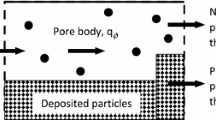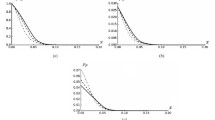Abstract
Particle detachment from the rock during suspension transport in porous media was widely observed in laboratory corefloods and for flows in natural reservoirs. A new mathematical model for detachment of particles is based on mechanical equilibrium of a particle positioned on the internal cake or matrix surface in the pore space. The torque balance of drag, electrostatic, lifting and gravity forces, acting on the particle from the matrix and the moving fluid, is considered. The torque balance determines maximum retention concentration during the particle capture. The particle torque equilibrium is determined by the dimensionless ratio between the drag and normal forces acting on the particle. The maximum retention function of the dimensionless ratio (dislodging number) closes system of governing equations for colloid transport with particle release. One-dimensional problem of coreflooding by suspension accounting for limited particle retention, controlled by the torque sum, allows for exact solution under the assumptions of constant filtration coefficient and porosity. The explicit formulae permit the calculation of the model parameters (maximum retention concentration, filtration and formation damage coefficients) from the history of the pressure drop across the core during suspension injection. The values for maximum retention concentration, as obtained from two coreflood tests, have been matched with those calculated by the torque balance on the micro scale.
Similar content being viewed by others
Abbreviations
- A 132 :
-
Hamaker constant, J
- C m :
-
Molar concentration of ith ion, L−3
- c :
-
Suspended particle concentration, L−3
- C :
-
Dimensionless suspended particle concentration
- D e :
-
Dielectric constant
- D :
-
Erosion front velocity, LT−1
- F :
-
Force, N
- h :
-
Separation length between particle and grain, L
- H :
-
Thickness of rectangular pore channel, L
- J :
-
Normalized pressure drop on the core
- k :
-
Absolute permeability, L2
- k det :
-
Particle detachment coefficient
- k r :
-
Dimensionless factor of permeability reduction due to particle retention
- k B :
-
Boltzmann constant, ML−2T−2K−1
- L :
-
Core (reservoir) length, L
- m :
-
Growth coefficient of the normalized pressure drop
- n :
-
Number concentration of pores in the rock, L−2
- p :
-
Pressure, MT−2L−1
- P :
-
Dimensionless pressure
- PVI:
-
Pore volume injected (dimensionless unit for time t D)
- r :
-
Radius of a particle or of a pore, L
- S :
-
Dimensionless retention concentration
- t :
-
Time, T
- T :
-
Absolute temperature, K
- u :
-
Interstitial velocity in porous space, LT−1
- U :
-
Darcy’s velocity in porous media, LT−1
- V :
-
Eenergy of interaction, ML2T−2
- x :
-
Coordinate, L
- z :
-
Valence of ith ion
- Z :
-
Ratio between the grain–particle separation distance and particle radius
- β :
-
Formation damage coefficient
- \({\varepsilon}\) :
-
Ratio between the drag and normal forces without retained particles
- \({\varepsilon_{\rm p}}\) :
-
Ratio between the drag and normal forces at the presence of retained particles
- \({\varepsilon_{0}}\) :
-
Free space permittivity, C−2J−1L−1
- κ :
-
Inverse Debye length, L−1
- κ C :
-
Coulomb dry friction coefficient
- λ′:
-
Dimensional filtration coefficient, 1/L
- λ:
-
Dimensionless filtration coefficient
- μ :
-
Dynamic viscosity, ML−1T−1
- ν :
-
Number concentration of ith ion far away from the surface, L−3
- ρ :
-
Density of carrier fluid, ML−3
- σ :
-
Concentration of retained particles
- σ LJ :
-
Atomic collision diameter, L
- \({\phi}\) :
-
Porosity
- χ :
-
Correction factor in lifting formula
- ψ :
-
Surface potential, mV
- ω :
-
Correction factor in equation for drag force
- BR:
-
Born (for energy potential)
- c:
-
Cake
- cr:
-
Critical (maximum) retained concentration
- d:
-
Drag
- DLR:
-
Double layer repulsion (for energy potential)
- e:
-
Electric
- l:
-
Lifting
- g:
-
Gravity
- i :
-
Index for ion
- LVA:
-
London–van der Waals (for energy potential)
- n:
-
Normal (for force)
- s:
-
Suspended (of particles)
- p:
-
Pore
- 0:
-
Initial condition or initial value (for permeability)
References
Akhatov I.S., Hoey J.M., Swenson O.F., Schulz D.L.: Aerosol focusing on micro-capillaries: theory and experiment. J. Aerosol Sci. 39, 691–709 (2008)
Al-Abduwani, F., Bedrikovetsky, P., Farajzadeh, R., van den Broek, W., Currie, P.: External filter cake erosion: mathematical model and experimental study. SPE paper 94635 presented at the SPE 6th European Formation Damage Conference. Scheveningen, The Netherlands. 25–27 May 2005
Altmann J., Ripperger S.: Particle deposition and layer formation at the cross flow micro filtration. J. Membr. Sci. 124, 119–128 (1997)
Amix R., Bass A., Whiting A.: Applied Reservoir Engineering. McGraw Hill Book Co, NY (1964)
Barenblatt G.I., Entov V.M., Ryzhik V.M.: Theory of Fluid Flows Through Natural Rocks. Kluwer Academic Publishers, Dordrecht (1990)
Bedrikovetsky P.G., Marchesin D., Checaira F., Serra A.L., Resende E.: Characterization of deep bed filtration system from laboratory pressure drop measurements. J. Petrol. Sci. Eng. 64(3), 167–177 (2001)
Bradford S.A., Simunek J., Bettahar M., van Genuchten M.T., Yates S.R.: Modeling colloid attachment, straining, and exclusion in saturated porous media. J. Environ. Sci. Technol. 37, 2242–2250 (2003)
Bradford S.A., Torkzaban S.: Colloid transport and retention in unsaturated porous media. A review of interface-, collector-, and pore-scale processes and models. Vadose Zone J. 7(2), 667–681 (2008)
Chauveteau, G., Nabzar, L., Coste, J.-P.: Physics and modelling of permeability damage induced by particle deposition. SPE paper 39463 presented at the SPE International Symposium on Formation Damage Control in Lafayette, Louisiana, 18–19 February 1998
Civan F.: Reservoir Formation Damage. Fundamentals, Modeling, Assessment, and Mitigation, 2nd edn. Gulf Professional Publishing, Burlington, MA (2007)
Dabrowski W.: Consequences of the Mass Balance Simplification in Modelling Deep Filtration. J. Water Res. 22(10), 1219–1227 (1988)
Derjagin B.V., Landau L.D.: Theory of the stability of strongly charged lyophobic sols and of the adhesion of strongly charged particles in solutions of electrolytes. J. Acta physicochim. URSS 14(6), 633–662 (1941)
Dullien F.A.L.: Porous Media: Fluid Transport and Pore Structure. Academic Press Inc, New York (1992)
Elimelech M.: Particle deposition onideal collectors from dilute flowing suspensions: Mathematical formulation, numerical solution, and simulations. J. Sep. Technol. 4, 186–212 (1994)
Elimelech M., Gregory J., Jia X., Williams R.A.: Particle Deposition and Aggregation. Butterworth- Heinemann, Boston (1995)
Entov, V.M., Mirzhadzhanzade, A.K.: Hydrodynamics in Drilling (in Russian). Nedra, Moscow (1990)
Foppen J.W.A., Schijven J.F.: Evaluation of data from the literature on the transport and survival of Escherichia coli and thermotolerant coliforms in aquifers under saturated conditions. J. Water Res. 40, 401–426 (2006)
Freitas A.M., Sharma M.M.: Detachment of particles from surfaces: an AFM study. J. Colloid Interface Sci. 233, 73–82 (2001)
Frimmel F.H., von der Kammer F., Flemming F.-C.: Colloidal Transport in Porous Media. Springer-Verlag, Berlin, Heidelberg (2007)
Gregory J.: Approximate expressions for retarded Van der Waals interaction. J. Colloid Interface Sci. 83(1), 138–145 (1981)
Herzig J.P., Leclerc D.M., Le Goff P.: Flow of suspensions through porous media—application to deep filtration. J. Ind. Eng. Chem. 65(5), 8–35 (1970)
Ilina T., Panfilov M., Buès M., Panfilova I.: A pseudo two-phase model for colloid facilitated transport in porous media. Transp. Porous Med. 71(3), 311–329 (2008)
Israelachvili J.: Intermolecular and Surface Forces. Academic Press, London (2006)
Jiao D., Sharma M.M.: Mechanism of cake build-up in cross flow filtration of colloidal suspensions. J. Colloid Interface Sci. 162, 454–462 (1994)
Johnson W.P., Li X., Assemi S.: Deposition and re-entrainment dynamics of microbes and non-biological colloids during non-perturbed transport in porous media in the presence of an energy barrier to deposition. Adv. Water Res. 30, 1432–1454 (2007)
Kang S.-T., Subramani A., Hoek E.M.V., Deshusses M.A., Matsumoto M.R.: Direct observation of biofouling in cross-flow microfiltration: mechanisms of deposition and release. J. Membr. Sci. 244, 151–165 (2004)
Khilar K., Fogler S.: Migration of Fines in Porous Media. Kluwer Academic Publishers, Dordrecht (1998)
Landau L.D., Lifshitz E.M.: Statistical Physics, Part 1 (Course in Theoretical Physics, vol. 5). Pergamon Press, Oxford (1980)
Landau L.D., Lifshitz E.M.: Fluid Mechanics (Course on Theoretical Physics, vol. 6), 2nd edn. Pergamon Press, Oxford (1987)
Logan D.J.: Transport Modeling in Hydrogeochemical Systems. Springer, New York (2001)
Miranda, R.M., Underdown, D.R.: Laboratory measurement of critical rate: a novel approach for quantifying fines migration problems. SPE paper 25432 presented at the Production Operations Symposium, Oklahoma City, OK, 21–23 March 1993
Nabzar, L., Chauveteau, G., Roque, C.: A new model for formation damage by particle retention. SPE paper 31119 presented at the SPE International Symposium on Formation Damage Control in Lafayette, Louisiana, 14–15 February 1996
Ochi J.J.-L., Vernoux J-F.: Permeability decrease in sandstone reservoirs by fluid injection. Hydrodynamic and chemical effects. J. Hydrol. 208, 237–248 (1998)
O’Neill M.E.: A sphere in contact with a plane wall in a slow linear shear flow. J. Chem. Eng. Sci. 23, 1293–1298 (1968)
Panfilov M., Stepanyants Y., Panfilova I.: Mechanisms of particle transport acceleration in porous media. Transp. Porous Med. 74(1), 49–71 (2008)
Pang, S., Sharma, M.M.: A model for predicting injectivity decline in water-injection wells. SPE paper 28489, vol. 12, No. 3, pp. 194–201, September 1997
Rahman, S.S., Arshad, A., Chen, H.: Prediction of critical condition for fines migration in petroleum reservoirs. SPE paper 28760 presented at the SPE Asia Pacific Oil and Gas Conference, Melbourne, Australia, 7–10 November 1994
Rousseau, D., Hadi, L., Nabzar, L.: Injectivity decline from produced water re-injection: new insight on in-depth particle-deposition mechanisms. SPE paper 107666, pp. 525–531, November 2008
Saffmann P.G.: The lift on a small sphere in a slow shear flow. J. Fluid Mech. 22, 385–400 (1965)
Saffmann P.G.: Correction to “The lift on a small sphere in a slow shear flow”. J. Fluid Mech. 31, 624 (1968)
Santos A., Bedrikovetsky P.G.: A Stochastic model for particulate suspension flow in Porous Media. Transp. Porous Med. 13, 30–52 (2006)
Schijven J.F., Hassanizadeh S.M.: Removal of viruses by soil passage: overview of modelling processes, and parameters. Crit. Rev. Environ. Sci. Technol. 30(1), 49–127 (2000)
Schechter, R.S.: Oil Well Stimulation, pp. 602. Prentice Hall, Englewood Cliffs, NJ (1992)
Seljakov V.I., Kadet V.V.: Percolation Models in Porous Media. Kluwer Academic, Dordrecht (1996)
Tufenkji N.: Colloid and microbe migration in granular experiments: a discussion of modelling methods. In: Frimmel, F.H., von der Kammer, F., Flemming, F.-C. (eds) Colloidal Transport in Porous Media, pp. 119–142. Springer-Verlag, Berlin (2007)
Tufenkji N., Elimelech M.: Correlation equation for predicting single-collector efficiency in physicochemical filtration in sarurated porous media. J. Environ. Sci. Technol. 38, 529–536 (2004)
Wennberg, K.E., Sharma, M.M.: Determination of the filtration coefficient and the transition time for water injection wells. Paper SPE 38181 presented at the SPE European Formation Damage Conference, 2–3 June, The Hague, Netherlands, 1997
Zinati F.F., Farajzadeh R., Currie P.K., Zitha P.L.J.: Modeling of external filter cake build-up in radial geometry. J. Petrol. Sci. Technol. 27(7), 746–763 (2009)
Author information
Authors and Affiliations
Corresponding author
Additional information
The paper is dedicated to memory of Vladimir Markovich Entov.
Rights and permissions
About this article
Cite this article
Bedrikovetsky, P., Siqueira, F.D., Furtado, C.A. et al. Modified Particle Detachment Model for Colloidal Transport in Porous Media. Transp Porous Med 86, 353–383 (2011). https://doi.org/10.1007/s11242-010-9626-4
Received:
Accepted:
Published:
Issue Date:
DOI: https://doi.org/10.1007/s11242-010-9626-4




